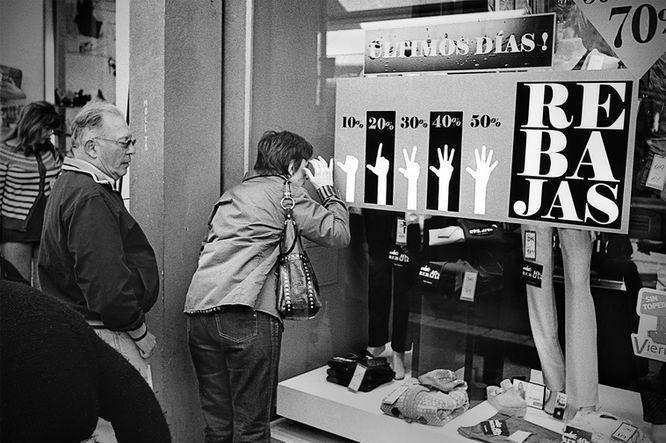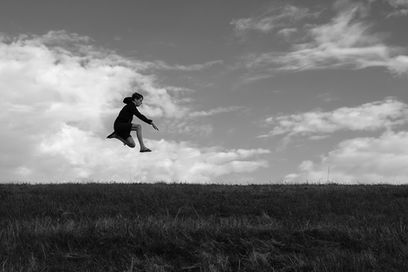
INTERVIEW
April 6, 2025
THERE MY LITTLE EYES
Photography and book by Guillermo Franco
Interview by Melanie Meggs
‘There My Little Eyes’ by Guillermo Franco is a deeply personal exploration of street photography, capturing fleeting moments of everyday life through the medium of black-and-white photography. This book, a fusion of Guillermo’s street photography with poetic and critical texts, offers a deeply introspective journey into the art of looking — where the act of observation takes precedence over the mere act of seeing. Drawing inspiration from photographers like Robert Frank and Henri Cartier-Bresson, Guillermo constructs a visual narrative that is both personal and universal, emphasizing intuition, patience, and the poetic potential of the mundane.
At the heart of ‘There My Little Eyes’ lies Guillermo’s distinction between seeing and looking. Guillermo distinguishes between seeing — a passive act — and looking, which he describes as an intentional, imaginative process that builds personal narratives. The book starts with texts, firstly by Rodrigo Fierro, then by Juan Travnik, followed by María Paulinelli. These texts establish a philosophical and critical foundation for Guillermo’s work. The poetry of Gastón Sironi serves as a structural element, reinforcing the interplay between image and language that deepens the book’s contemplative nature.
The book also explores time and memory through Guillermo’s use of analog photography. The notion of the ‘latent image’ — a photograph that exists in the mind before being developed — suggests that Guillermo’s photography is as much about anticipation and recollection as it is about the moment of capture. He often waits hundreds of days before developing his film, allowing time to shape the meaning of his images. This philosophy stands in stark contrast to the instantaneous nature of digital photography and social media, where images are consumed and discarded at an accelerated pace. This deliberate delay by Guillermo adds a layer of mystery and introspection, transforming each photograph into a meditation on memory and perception.
Guillermo captures urban life with a sense of wonder, often highlighting the humor, irony, and beauty in ordinary encounters. His photographs reveal an intuitive playfulness, echoing Juan Travnik’s observation that Franco possesses a childlike ability to be surprised. This perspective aligns his work with the tradition of the ‘flâneur’ — the wandering observer who collects fragments of human existence with curiosity and sensitivity. Guillermo’s unfiltered documentation of life aligns with the tradition of classic street photography, yet his photographs lean into poetic ambiguity. Shadows, reflections, and juxtapositions play a crucial role in his compositions, inviting the viewer to interpret the significance of each captured moment rather than prescribing a definitive meaning.
Additionally, ‘There My Little Eyes’ resists the conventional categorization of photography as either documentary or artistic. Guillermo’s work exists in a liminal space where reality and imagination converge. His process recalls the practice of Henri Cartier-Bresson, who famously walked the streets sometimes “taking photographs” without film, training his eye to perceive without the immediacy of documentation. “Every so often I emulate it, I walk through life with an (analog) camera without film, and I look; I look and I press the shutter, I press it and I vibrate, I vibrate and I breathe, I breathe and I live.” Guillermo’s images are informed by a deep internalization of his surroundings — his gaze becoming the true subject of the book rather than the photographs themselves.
‘There My Little Eyes’ is a poetic meditation on the nature of photography, memory, and everyday life. Guillermo’s use of black-and-white analog photography, combined with a thoughtful selection of texts, creates a book that is as much about looking as it is about seeing. His approach challenges the viewer to slow down, to engage deeply with images, and to embrace the unseen layers of meaning embedded in the ordinary. By doing so, he continues the legacy of great street photographers while carving out a distinctly personal vision — one that values patience, intuition, and the quiet poetry of daily existence.
‘There My Little Eyes’ is more than a photobook — it is a meditation on time, perception, and the art of looking. Guillermo’s black-and-white analog photography, combined with poetic and philosophical reflections, creates a work that challenges conventional photographic discourse. By prioritizing intuition over immediacy, patience over production, and observation over documentation, Guillermo redefines what it means to engage with the world through photography. His photographs exist in a space where reality and imagination merge, allowing the viewer to construct their own meanings. In an era of visual overload, ‘There My Little Eyes’ serves as a tribute to the lasting impact of slow, thoughtful photography — an invitation to see beyond the visible and into the poetic depths of everyday life.
We now move from the reflective nature of Guillermo Franco’s book to a conversation with the artist himself.

“Looking is like seeing, but with feeling; like thinking, but with the eyes; like observing, but with the soul. In life, we first breathe, and then — soon — we open our eyes. I photograph to dream with my eyes open.”
IN CONVERSATION WITH GUILLERMO FRANCO
THE PICTORIAL LIST: What was the driving force behind creating your photobook ‘There My Little Eyes’? Were you looking to tell a specific story or explore a new way of presenting your photography?
Guillermo: I just wanted to share my perspective with friends and acquaintances. The book wasn't meant to be sold. Once it was published, I gave away every copy. I like to say it's "out of print" without having sold a single copy.
TPL: What was the most challenging aspect of creating this book, either technically, emotionally, or conceptually?
Guillermo: We were four friends — Rodrigo Fierro, curator; Santiago Guerrero, designer; Gastón Sironi, editor; and me — making graphic decisions and celebrating friendship. Each workday culminated with an asado (a traditional barbecue from our country, Argentina) and a toast. We worked hard, yes, but we enjoyed ourselves immensely.
TPL: ‘There My Little Eyes’ opens with texts from Rodrigo Fierro, Juan Travnik, María Paulinelli and poems by Gastón Sironi. Tell us about each of them and their importance to you in your life.
Guillermo: People I admire and appreciate. Intellectual role models and emotional companions. Individuals as discerning as they are noble. I feel honored to have had their support.
TPL: You emphasize the difference between ‘seeing and looking’. How has your understanding of this distinction evolved throughout your life?
Guillermo: Seeing is simply exercising a sense, that of sight. Something that we all do in a similar way, as long as we do not suffer from a significant visual impairment. Looking, on the other hand, is a more unique, rich and complex action.
To look may be a verb that includes other verbs: feel, desire, think, want, love...
Seeing is something that involves us all. Looking involves each of us. And “all” is not the same as “each”. Not even the “all” is the sum of the “each”. Luckily, we all see the same things, but fortunately each of us looks differently.
We see only the visible. We also look at the invisible.
Looking builds looks. And that is the only heritage of photographers: their gaze.
Photography is definitely a matter of looking. Not to see, to look.
Ramón Gómez de la Serna says: “I am neither a thinker nor a writer, I am a viewer.”
TPL: Your process involves long periods between capturing, developing, and sharing an image. Can you walk us through your emotional journey from taking a photo to finally seeing the developed print?
Guillermo: Let’s Garry Winogrand answer the question for me: “You make better choices if you approach your contact sheets cold, separating the editing from the picture taking as much as possible.”
Taking a photograph takes a moment, appreciating it...an eternity.

TPL: Sometimes Henri Cartier-Bresson used to walk around shooting without film to train his eye. You have mentioned doing something similar. What have you learned from this exercise?
Guillermo: What matters is the gaze, not the photographs. Prioritize the observation, the vibration of the instant, the snap, not the resulting images.
TPL: You mention that your photography is neither artistic nor documentary but rather a ‘loving act’. Could you elaborate on what this means to you?
Guillermo: I like to believe that my gaze is that of a child. Sometimes cheeky, shameless, innocent, immature...Also puzzled, without any certainty, surprised…At times affectionate, full of love, tender...
“Tender” is a word that is uncommon in the glossary of contemporary photography, unfortunately.
I always remember a song by Bob Dylan: “Everybody's wearing a disguise / To hide what they've got left behind their eyes / But me, I can't cover what I am / Wherever the children go I'll follow them.”
And a reflection by Robert Frank: “Most of my photographs are of people; they are seen simply, as through the eyes of the man in the street. There is one thing the photograph must contain, the humanity of the moment.”
TPL: The idea of ‘latent images’ — those that exist only in memory before they are developed — is central to your work. Why do you still use analog cameras?
TPL: If you could go back and give advice to your younger self, when you first started taking photographs, what would you say?
Guillermo: So many tender moments... A foolish attempt to hold them in forever? Click!
TPL: What do you ultimately hope to leave behind as a photographer? If people remember your work years from now, what do you want them to take away from it?
Guillermo: I answer by paraphrasing a musical composition by Babasónicos: “Song (Photography) take me far away, where no one remembers me. I want to be the murmur (the look) of a city that doesn't know who I am.”
TPL: When you are not out capturing those special moments of everyday life, what would we find Guillermo doing?
Guillermo: Watching clouds, blowing dandelions, catching dreams...

Guillermo Franco’s ‘There My Little Eyes’ is an exploration of seeing beyond the obvious. Through his thoughtful responses, Guillermo reveals a philosophy rooted in intuition, curiosity, and a deep appreciation for the unnoticed moments that shape human experience. His distinction between seeing and looking underscores the emotional and intellectual engagement required in photography.
By embracing the latent image Guillermo resists the fast-paced, disposable nature of modern photography. Instead, he invites us to slow down, to engage with the world more intimately, and to find beauty in the ordinary. His images, like his words, remind us that photography is not just about preserving the past — it is about feeling, dreaming, and truly looking.
Guillermo, both as a photographer and as a storyteller, inspires us to see — not just with our eyes, but with our hearts.










































